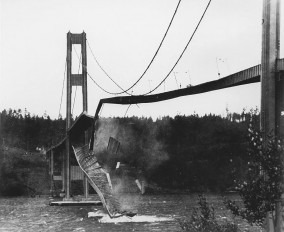
The New Cooper River Bridge in Charleston, South Carolina, is the longest cable-stayed bridge in North America. The bridge's suspended span length is approximately 1005m and consists of a main span, two side spans, and two anchor spans. Figure 1 presents the Central part of the Cooper River Bridge. The deck, which carries 8 traffic lanes and a pedestrian/bikeway, is supported by two towers in the shape of a diamond, around 175m tall. A composite concrete deck with I-shaped steel edge girders supports the main span. The border girder that supports the pedestrian/bicycle walkway is cantilevered outside of it. The high level approaches also make use of steel girders and composite steel construction. Over their entire lengths, which are roughly 1326m on the Charleston side and 637m on the Mount Pleasant side, both high approaches are jointless.

For the designing process, SC Solutions, of California, used ADINA. Different options, i.e. ADINA, ADINA Advanced and ADINA Ultimate, are now available for performing advanced non-linear simulations. ADINA is used for Mechanical, Structural and Bridge engineers as it gives the ability to simulate the extremely non-linear behavior, the multi-body dynamics and the physical behavior of digital twins of infrastructure. The advanced non-linear simulations for either design or evaluation of infrastructure, provide greater accuracy of expected performance, subject to normal operational and extreme environmental effects.
The main span unit of the bridge's and the West and East high level approach structures were combined in a single model and were subjected to inelastic time history analysis as part of design assessments for the bridge's seismic performance. This "global" model, which had roughly 55,000 degrees of freedom, was subjected to time histories of ground motion that varied geographically.
The soil-structure interaction was formally modeled with plasticity-based truss elements, and pushover assessments of the standalone tower/foundation models were carried out to validate the characterizations of the physical behaviors (Figure 2). These are only a few of the specifics.

The bridge's center gets loaded by earthquakes in the animation up above (with the movements magnified 50 times). Such nonlinear simulations naturally call for the use of a solid engineering background in seismic problem modeling as well as the usage of a powerful and trustworthy analytical tool like ADINA.
Source: Bentley Systems Community
Want to read more like this story?

Types of bridges
Jun, 01, 2023 | EducationArch Bridge An arch bridge is a type of bridge that uses a curved, semi-circular structure, kno...

An engineering point of view for the Tacoma Narrows Bridge collapse
Apr, 04, 2023 | EducationIntroduction An iconic civil structure is a bridge. The desire for humans to go from place to...

New bridge building method : The "umbrella" method
Aug, 05, 2020 | NewsA new bridge construction method, which was introduced by structural engineers at the Vienna Univer...

Bentley Systems Announces Acquisition of ADINA to Extend Nonlinear Simulation throughout Infrastructure Engineering
May, 05, 2022 | NewsBentley Systems announced it has acquired Watertown, Massachusettsbased ADINA R & D Inc., a lea...

New design to make bridge spans longer
Sep, 27, 2018 | NewsLonger bridge spans will be achieved in the future by the utilization of new bridge forms. Resear...

The most famous bridges of the world
Aug, 26, 2015 | NewsThere are so many bridges in the world in different styles, like old stone bridges or steely, footbr...

World's most frightening bridges to cross: Part 1
Mar, 20, 2020 | NewsBridges are structures that enable crossings over physical barriers including rivers, valleys and c...

10 of the longest floating bridges worldwide
Apr, 24, 2024 | NewsConsidered feats of modern engineering, floating bridges play a crucial role in areas where underwa...

Modeling the buckling behavior of bridge braces: the example of San Francisco-Oakland Bay Bridge
Jul, 17, 2023 | NewsThe California Toll Bridge Seismic Retrofit Program was initiated by the California Department of T...
Form
Looking for more information? Fill in the form and we will contact Bentley for you.
Trending

Spectacular interchanges around the world

New Release - STAAD.Pro 2024 - 2

ADINA 2025 for Structural WorkSuite

ADINA 2025 New Release!

Concrete Buildings as Rechargeable Batteries

Powerful earthquake shakes central Philippines, dozens killed


